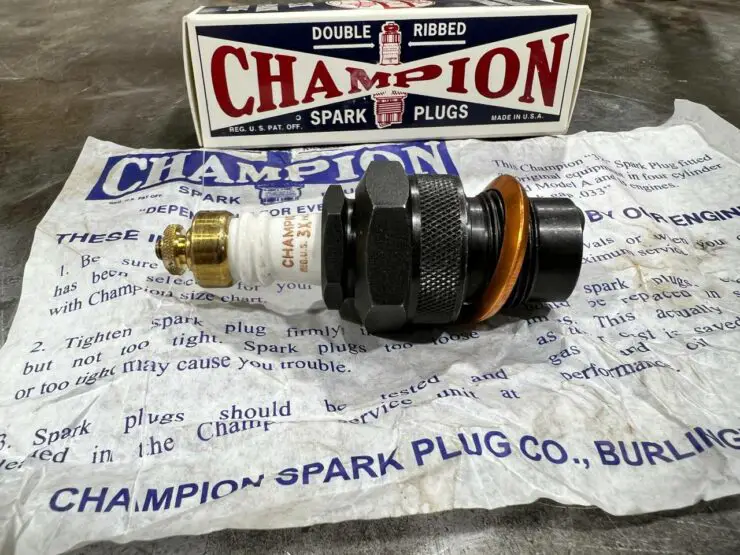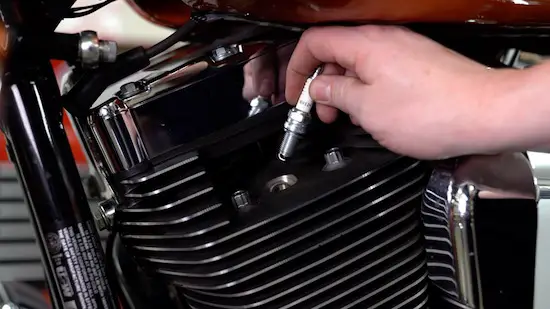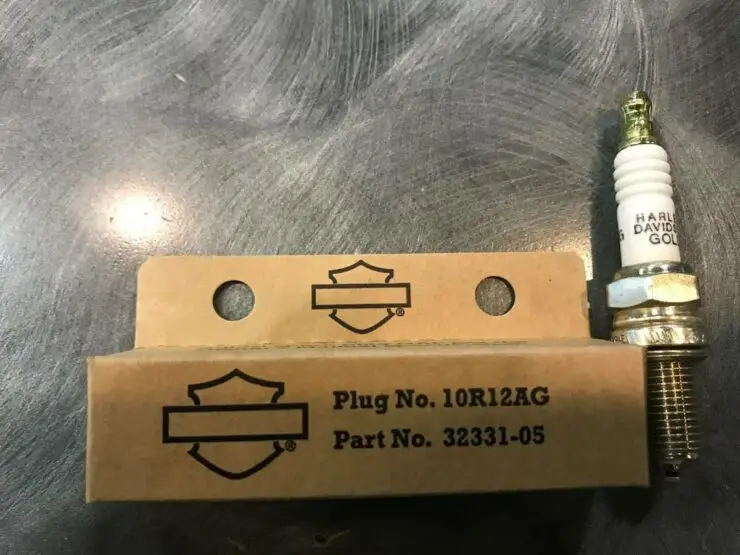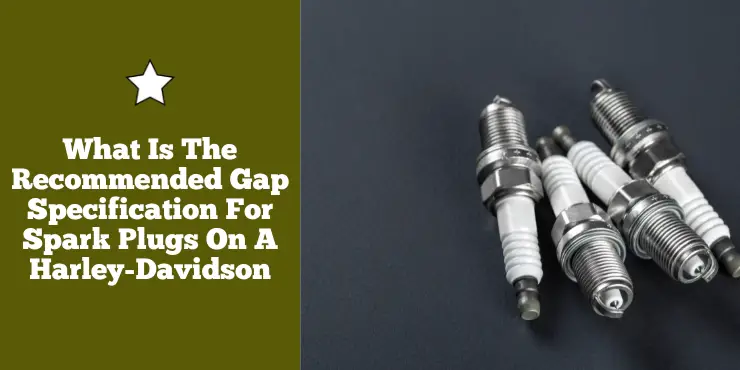Do you own a Harley-Davidson and want to ensure that your spark plugs are performing optimally?
The recommended spark plug gap for Harley-Davidson models typically ranges from 0.038 to 0.043 inches, but check the manual for model-specific details.
In this article, we will be diving into the fascinating world of spark plugs and answering the burning question – what is the recommended gap specification for spark plugs on a Harley-Davidson? Whether you’re a seasoned rider or a curious enthusiast, understanding the correct gap specification is crucial for your bike’s performance. So, let’s rev our engines and get started on this quest for spark plug knowledge!
Overview of spark plugs in Harley-Davidson bikes
In the world of internal combustion engines, spark plugs are often the unsung heroes that play a key role in igniting the air-fuel mixture and propelling the engine and your Harley-Davidson bike forward. A spark plug is a small but vital component in an internal combustion chamber, serving the primary purpose of igniting the air-fuel mixture within the engine’s cylinders. This ignition process will generate the controlled explosion needed to power the engine, converting chemical energy into mechanical energy and propelling the vehicle forward.
>>> Click here to read our review of the Best Harley-Davidson Spark Plugs <<<
The significance of spark plugs in internal combustion engines simply cannot be overstated. Spark plugs initiate the combustion process by creating a spark that ignites the air-fuel mixture. This precise and controlled ignition will be important for efficient engine operation. Moreover, spark plugs also ensure that the air-fuel mixture burns consistently and uniformly within the combustion chamber. This promotes efficient combustion, reducing emissions and improving fuel efficiency.
The quality of spark plugs directly impacts engine performance. High-quality spark plugs promote smoother operation, consistent power output, and better acceleration, ensuring an enjoyable riding experience.
Modern spark plugs are designed to minimize emissions by promoting complete combustion. This will contribute to reduced environmental impact and compliance with emissions regulations. Reliable spark plugs are important for the overall reliability of the engine. A faulty spark plug could result in misfires, reduced power, and engine damage.
Here is a closer look at the different components that make up a spark plug in a Harley-Davidson bike –
#1. Shell
The shell or housing of a spark plug is typically made of metal (usually steel or aluminum) and serves as the outer casing that threads into the engine cylinder head. The shell dissipates heat generated during combustion and offers structural integrity.
#2. Insulator
The insulator is a ceramic component that extends from the shell’s bottom to the top, separating the central electrode from the shell. It acts as the electrical insulator, ensuring that the spark only occurs at the electrode tip.
#3. Central electrode
The central electrode is a metal rod protruding into the combustion chamber. The central electrode is connected to the ignition system and conducts electricity for generating the spark. The tip of the central electrode will be exposed to the combustion chamber.

#4. Ground electrode
Opposite the central electrode will be a ground electrode, which is made up of metal. It extends into the combustion chamber and forms a small gap with the central electrode. This gap is where the spark occurs, igniting the air-fuel mixture.
#5. Spark plug boot
The spark plug boot is the connector that attaches to the top of the spark plug. It offers an electrical connection between the ignition coil and the spark plug.
What is the significance of the spark plug gap?
When you rev up your Harley-Davidson bike, you will be having the culmination of precise engineering and meticulous design. At the heart of this roaring beast lies a small but critical component known as the spark plug. One of the critical aspects of spark plugs is the spark plug gap.
The spark plug gap refers to the distance between the center electrode and the ground electrode inside the spark plug. This rather small gap plays a key role in the ignition process and can significantly impact the performance of your Harley-Davidson bike.
The spark plug gap directly affects the timing of ignition. When the gap is set correctly, the spark will occur precisely at the optimal moment in the engine’s cycle. This will ensure that the air-fuel mixture ignites when the piston is at the right position in the cylinder, maximizing power and efficiency.
Properly adjusted spark plug gaps promote complete and efficient combustion. When the spark plug gap is too wide, the spark might not be strong enough to ignite the mixture reliably. Conversely, if the gap is too narrow, it could cause premature ignition and result in engine knocking. The right gap size will ensure a clean and efficient burn, enhancing engine performance and fuel efficiency.
Harley-Davidson bikes, like all modern vehicles, need to adhere to strict emission standards. An appropriately set spark plug gap will contribute to cleaner combustion, reducing harmful emissions. This is important for both environmental compliance and reducing the carbon footprint.
A well-maintained spark plug gap will contribute to the longevity of your motorcycle’s engine. When combustion is efficient and controlled, it will reduce stress on engine components, minimizing wear and tear. This can extend the life of your Harley-Davidson motorcycle and help you enjoy it for years to come.
Set the spark plug gap
Setting the spark plug gap will require precision and attention to detail. Here is how you can set the gap for your Harley-Davidson bike –
- Consult your motorcycle’s owner’s manual or a service manual for determining the recommended spark plug gap specification for your specific model and engine type
- Make use of a gapping tool designed for spark plugs, which features a round wire or feeler gauge
- Gently insert the tool between the center electrode and the ground electrode
- After that, carefully adjust the gap by bending the ground electrode if necessary until it matches the recommended specification
- Make sure that the gap is uniform until all the way around and free of debris
- Double-check to ensure that the gap remains within the specified range
What happens if there is an incorrect spark plug gap?
For Harley-Davidson enthusiasts, the joy of riding isn’t only about the open road. It is also about the symphony of power and performance that their motorcycles offer. At the heart of the performance lies a tiny but significant component – the spark plug. While often overlooked, the spark plug gap plays a key role in determining the engine’s performance, combustion efficiency, and other departments. If you are wondering what happens if there is an incorrect spark plug gap, then the short answer is a lot. Here is the detailed answer on what happens if there is an incorrect spark plug gap.
#1. Engine performance
An incorrect spark plug gap can result in frequent misfires and difficulty starting your bike. If the gap is too wide, the spark might not be strong enough to ignite the air-fuel mixture consistently. Conversely, if the gap is too narrow, it can result in premature ignition or even complete failure to fire, causing starting problems and rough idling.
Proper combustion is important for generating power in your motorcycle’s engine. An improper spark plug gap might disrupt this process, resulting in reduced power output. A spark that is too weak or too strong can result in incomplete combustion, robbing your bike of its full potential.
#2. Combustion and fuel efficiency
When the spark plug gap is not correct, it will result in incomplete combustion. Incomplete combustion results in wasted fuel, increased emissions, and a reduction in overall engine efficiency. This can manifest as decreased fuel economy and poor performance.
A narrow spark plug could cause the air-fuel mixture to ignite prematurely, leading to engine knocking. This doesn’t just affect engine performance but also increases the risk of engine damage over time.
#3. Fuel efficiency
Inefficiency in combustion and power generation will result in increased fuel consumption. An incorrect spark plug gap can result in lower fuel efficiency, costing you more money at the pump and contributing to environmental pollution.
Harley-Davidson, like all modern manufacturers, should meet stringent emission standards. An improperly set spark plug gap can result in higher emissions, potentially causing your motorcycle to fail emissions tests or contribute to environmental pollution.
#4. Power and acceleration
An incorrect spark plug gap can greatly impact power and acceleration. A gap that is too wide can result in a weak spark, which translates to sluggish acceleration and reduced top-end speed. Conversely, a gap that is too narrow can result in erratic performance and poor throttle response.
For Harley-Davidson riders, the thrill of the ride is paramount. An incorrectly set spark plug gap can make your motorcycle’s performance unpredictable, affecting your overall riding experience and enjoyment.

Factors that influence the spark plug gap in Harley-Davidson motorcycles
As mentioned before, the spark plug plays a key role in the ignition process. More precisely, the spark plug gap is of utmost importance. When determining the spark plug gap in Harley-Davidson bikes, you will have to consider a number of factors. Here are some of the factors that influence the spark plug gap in Harley-Davidson bikes.
#1. Engine design and specifications
One of the factors that determine the spark plug gap will be the specific design and specifications of the engine in your Harley-Davidson motorcycle. Different engines come with varying compression ratios, combustion chamber designs, and ignition systems, all of which impact the ideal spark plug gap. Manufacturers provide recommended spark plug gap settings tailored to each engine model for ensuring optimal performance.
Larger engine displacements often need wider spark plug gaps for ensuring effective combustion. Similarly, the design of the combustion chamber, whether it is a V-twin or a different configuration could influence the ideal gap setting.
The compression ratio, which measures the difference in volume between the cylinder when the piston is at the bottom and the top of the stroke, significantly greatly affects the spark plug gap. Higher compression ratios need narrower gaps to prevent spark blowout during ignition.
#2. Fuel quality and type
The type and quality of fuel you are using in your Harley-Davidson motorcycle can influence the spark plug gap. Different fuel types, such as regular unleaded, premium, or ethanol-blended fuels have different combustion characteristics. Using a higher-octane fuel might require a different spark plug gap to ensure efficient ignition and prevent engine knock.
The efficiency of your motorcycle’s air intake system, including the air filter and intake design, can affect the spark plug gap. A high-flow air filter or aftermarket intake system can change the air-fuel mixture, necessitating gap adjustments for optimal combustion.
#3. Ignition system
The ignition system in your Harley-Davidson bike plays a critical role in determining the spark plug gap. Modern bikes often feature advanced electronic ignition systems that can adjust the spark timing and intensity based on various factors, including engine load and operating conditions. These systems might require specific spark plug gap settings to work optimally.
#4. Environmental conditions
Environmental factors like temperature and altitude can affect the spark plug gap. In colder temperatures, a narrower gap might be needed to ensure reliable ignition while in hot conditions, a slightly wider gap may be preferred to prevent overheating. Similarly, bikes operated at higher altitudes might require adjustments to the spark plug gap to compensate for reduced air density.
#5. Modifications and performance upgrades
Many Harley-Davidson enthusiasts enjoy customizing and upgrading their motorcycles for improved performance. These changes can alter engine characteristics and might necessitate changes to the spark plug gap. For instance, installing a high-performance camshaft or exhaust system might require gap adjustments to optimize the spark plug gap settings.
Performance modifications, such as installing a high-flow air filter, aftermarket exhaust, or engine tuning might alter the spark plug gap. Fine-tuning the spark plug gap will ensure that your motorcycle’s engine operates efficiently with these enhancements.
#6. Riding style and conditions
Your riding style and the conditions in which you’re riding could also impact the spark plug gap. Aggressive riding or consistently high speeds might create different combustion requirements compared to leisurely cruising. Additionally, frequent stop-and-go city riding versus long highway stretches could also influence the spark plug gap settings.
What is the recommended gap specification for spark plugs on a Harley-Davidson?
Harley-Davidson is known for its diverse lineup, catering to a wide range of riders and riding styles. While the motorcycles share the iconic V-twin engine design, each series within the Harley-Davidson family might have unique characteristics that influence the spark plug gap recommendations. This may make you wonder what is the recommended gap specification for spark plugs on a Harley-Davidson. The recommended spark plug gap specification for Harley-Davidson bikes will vary depending on the model and year. Generally, the gap should be set somewhere between 0.030 and 0.050 inches. To know the precise measurements, you should consult your bike’s owner’s manual.
Here are the different spark plug gap recommendations for the popular Harley-Davidson motorcycle series –

Harley-Davidson Sportster Series
The Harley-Davidson Sportster Series is well-regarded for its nimble handling and classic styling. Sportster engines tend to be similar in displacement compared to other Harley-Davidson models, often ranging from 883cc to 1,200cc. Due to the smaller engine size and typically lower compression ratios, Sportsters typically need a narrower spark plug gap. The recommended spark plug gap for Harley-Davidson Sportster Series is 0.040 to 0.045 inches (1.02 to 1.14mm)
Harley-Davidson Softail Series
The Harley-Davidson Softail Series combines classic looks with modern performance and comfort. Softail engines typically range from 1,600cc to 2,147cc, offering a substantial increase in power compared to the Sportster series. With higher engine displacement and varying compression ratios, spark plugs, and spark plug gap recommendations might differ. The recommended spark plug gap for the Harley-Davidson Softail Series is 0.040 to 0.045 inches (1.02 to 1.14mm).
Harley-Davidson Touring Series
Harley-Davidson Touring motorcycles are designed for long-distance cruising, comfort, and versatility. These bikes come equipped with larger engines, often ranging from 1,745cc to 1,900 cc, and might have different engine configurations. Due to the bigger engine size and higher compression ratios, the spark plug gap might be a bit wider. The recommended spark plug gap for the Harley-Davidson Touring Series is 0.045 to 0.050 inches (1.14 to 1.27mm).
Harley-Davidson Dyna Series
The Harley-Davidson Dyna Series offers an impressive blend of power and agility. Dyna engines generally range from 1,585cc to 1,802cc, offering a strong punch when you twist the throttle. Like the Softail Series, Dyna bikes might have varying compression ratios, which can influence the spark plug gap. The recommended spark plug gap for the Dyna Series is 0.040 to 0.045 inches (1.02 to 1.14mm).
When you’re looking to determine what is the recommended gap specification for spark plugs on a Harley-Davidson bike, there are certain important considerations. You must refer to your bike’s owner’s manual for the manufacturer’s recommended spark plug gap. These recommendations can vary slightly depending on the year and submodel of your Harley.
Modifications, aftermarket parts, and engine tuning may influence the ideal spark plug gap. If you’ve got any modifications to your motorcycle, consult with a qualified technician or refer to the manufacturer’s guidelines for adjustments.
Riding conditions and climate might also affect the spark plug gap. For instance, riding at high altitudes with thinner air might require a different gap setting to maintain efficient combustion.
Symptoms of incorrect spark plug gap in your Harley-Davidson bike
Harley-Davidson bikes are known for their iconic design and powerful engines. However, even the most legendary machines may face performance issues if the components aren’t maintained properly. In the spark plug, the spark plug is a critical factor when it comes to maintaining optimal engine performance. If you do not have the correct spark plug gap, there might be more problems than before. Here are some of the symptoms of an incorrect spark plug gap in your Harley-Davidson motorcycle.
#1. Engine misfires or rough idling
One of the noticeable symptoms of an incorrect spark plug gap in a Harley-Davidson motorcycle is an engine misfire or a rough idling experience. When the gap is too wide or too narrow, it can result in irregular and inconsistent sparks during the combustion process. This irregular ignition can result in cylinders firing at the wrong time, resulting in misfires.
Here are the symptoms of engine misfires or rough idling –
- Your engine might sputter or hesitate during acceleration
- You might experience a noticeable loss of power and a reduction in overall engine performance
- The motorcycle might produce a rough and uneven idle, causing vibrations and discomfort while at a standstill
- The exhaust note might sound irregular and choppy
#2. Decreased fuel economy
An incorrect spark plug gap might also impact the fuel economy of your Harley-Davidson motorcycle. Inefficient combustion due to a misaligned gap can result in incomplete burning of the air-fuel mixture. This inefficiency results in wasted fuel, causing your motorcycle to consume more fuel than needed for a given distance traveled.
Here are the symptoms of decreased fuel economy –
- A noticeable decrease in miles per gallon (MPG)
- Increased fuel expenses over time
- Frequent visits to the gas stations and reduced riding range
#3. Difficulty starting the engine
If the spark plug gap isn’t within the manufacturer’s recommended specifications, it can result in difficulties in starting the engine, especially in cold conditions. When the gap is too wide, the spark might not be strong enough for igniting the air-fuel mixture effectively, causing prolonged cranking or engine flooding.
Here are the symptoms of difficulty starting the engine –
- Repeated attempts to start the engine, especially in cold weather
- Longer cranking times before the engine starts
- The engine might backfire or fail to start altogether in extreme cases
FAQs
What is the ideal spark plug gap specification for a Harley-Davidson motorcycle?
The recommended spark plug gap specification for a Harley-Davidson motorcycle varies depending on the model and year. It is important to consult the owner’s manual or reach out to a qualified mechanic to determine the specific gap measurement for your bike. However, a general guideline is to set the gap between 0.030 and 0.040 inches.
How do I determine the correct spark plug gap for my Harley-Davidson?
To determine the correct spark plug gap for your Harley-Davidson, you should refer to the owner’s manual. The manual will specify the ideal gap measurement for your particular model and year. It is crucial to follow the manufacturer’s recommendations to ensure proper combustion and engine performance.
What happens if the spark plug gap on my Harley-Davidson is incorrect?
If the spark plug gap on your Harley-Davidson is incorrect, it can lead to various issues. A gap that is too small may cause misfires, difficulty starting the engine, or poor fuel efficiency. On the other hand, a gap that is too large can result in weak or no spark, leading to rough idling, reduced power, or even engine stalling. It is essential to maintain the recommended spark plug gap to ensure optimal performance and longevity.
>>> Read more about Harley-Davidson Spark Plugs <<<

